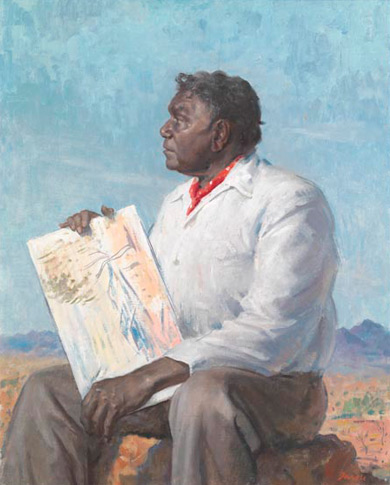Albert Namatjira
Namatjira poses at an angle to the viewer, his face slightly turned to create the perfect profile. His head is held high as he looks out across his country.
What words would you use to describe Namatjira’s pose and expression?
What does Namatjira’s pose and expression tell you about his character?
Dargie has located Namatjira in his country in the MacDonnell Ranges. Holding one of his own landscapes, the portrait represents the intrinsic connection between the artist’s painting and identity.
Discuss Dargie's use of landscape in his portrait of Namatjira.
Namatjira holds his painted landscape vertically, in what is generally referred to as ‘portrait’ format.
Discuss Namatjira’s landscape paintings as a form of portraiture.
The artist uses perspective to emphasise the vast distances of the Australian outback. By creating a low horizon in the background, the artist also exaggerates the scale of the figure in the landscape.
How does Dargie’s use of scale and perspective influence the way you view the portrait?
In 1956 William Dargie was awarded the Archibald Prize for an earlier portrait of Namatjira. At the time, the artist claimed that Namatjira’s ‘tremendous inner dignity,’ contributed to ‘the most wonderful face for a portrait I’ve ever seen’.
View Dargie’s 1956 portrait online at the Queensland Art Galley.
Move your mouse over the portrait to
see the points of interest.
About the artist
William Dargie was born in 1912 in Footscray, Victoria. After training as a teacher, he studied art at the Melbourne Technical College and from 1934 was a member of the Victorian Arts Society.
Dargie was appointed an official war artist with the Australian Infantry Force in 1941 and produced a large number of military portraits. While digging a trench in Tobruk in 1942 he received news that he had won his first Archibald Prize.
Dargie won a record number of eight Archibald Prizes between 1941-1956. His final prize, awarded in 1956, was for an earlier portrait of Namatjira that was, in his opinion, one of his best works.
The National Portrait Gallery has a collection of seventeen portraits by William Dargie, including a self portrait painted in the late 1930s.


